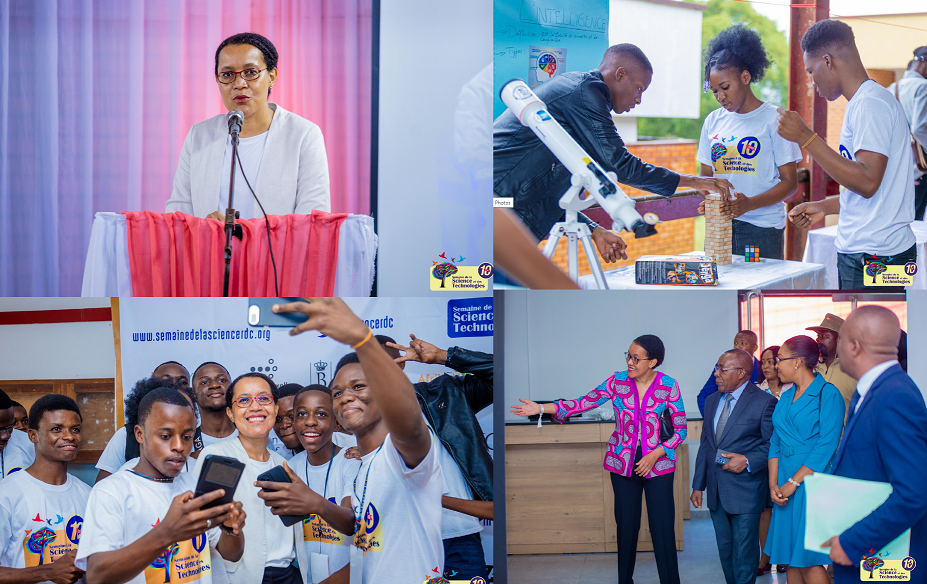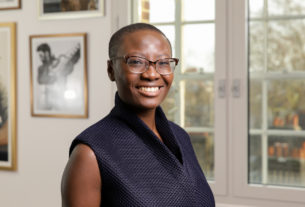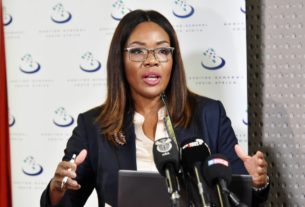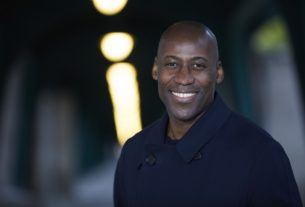The tenth edition of the Science and Technology Week (SST) took place from April 18 to 22 in Kinshasa and Mbanza-Ngungu, in the province of Central Kongo. Raïssa Malu, founder of the ASBL Investing In People, which organizes the event, looks back on the challenges of this anniversary edition, on the innovations recorded during the ten years of existence of the SST and on the ambitions of this scientific event, aimed at the youth.
Africanshapers: This year you organized the 10th consecutive edition of the Science and Technology Week (STW) in the DRC. Could you remind us what SST is and what its objectives are?
Raïssa Malu: Science and Technology Week is organized in the Democratic Republic of Congo by the non-profit association “Investing In People”, which I manage, in partnership with the Ministry of Primary, Secondary and Technical Education, the Ministry of Higher and University Education, the Ministry of Scientific Research and Innovation, and the NGO Elongo Elonga. This event has three objectives: to develop a scientific and technological culture in Africa; to promote African knowledge and know-how in these fields; and, above all, to encourage vocations among girls and boys.

What motivated you to launch this week 10 years ago?
I wanted to help reconcile the public with technical and scientific disciplines. They are often fearful disciplines that evoke bad memories of school years. Yet scientists enjoy their work. Everyone should enjoy it. This is why I created, with friends, the science and technology week.
What activities are being organized during this tenth edition?
There are the activities of the main program and the activities of the provincial teams. For the main program, we had two science villages with scientific animations and exhibitions, one at the Institut Supérieur Pédagogique in Mbanza-Ngungu, in the Kongo Central province, on Saturday 15 April, and the other at the Institut de la Gombe in Kinshasa, on 20 and 21 April. We also organized two days of conferences on Monday 17 April at the Kongo University in Kongo Central, and on Wednesday 19 April, at the Wallonie Bruxelles center in Kinshasa. On Saturday 22 April, we had a grandiose closing evening at the Wallonie Bruxelles centre in Kinshasa with an original play written by Professor Madimba Kadima-Nzuji with the actor Michel Bohiri, and an enchanting concert of classical music with the youth orchestra of the Kimbanguiste symphony orchestra.
For the parallel activities, we managed to establish a network of about 20 volunteer teams in 12 provinces of the DRC who organized scientific animations, conferences and trainings in their region. These 12 provinces are : Haut-Katanga, Ituri, Kasai-Central, Kinshasa, Kongo-Central, Kwilu, Lomami, Lualaba, Mai-Ndombe, North Kivu, South Kivu and Tanganyika.
Why the choice of the theme “10 years of Science and Technology in the service of youth. Victories of the past, hopes for the future”?
To look back on the nine previous editions and imagine our future together.

This anniversary edition was placed under the High Patronage of the African Union. Why was this? And what has been the AU’s contribution to the organization of the SST?
The SST contributes in the DRC to aspiration 6 of the African Union’s Agenda 2063 – an Africa whose development is led by its citizens, relying on the potential of African people, in particular, women and youth, and the care of children – as well as aspiration 7 – Africa as a strong, united, resilient and influential global actor and partner. The Special Representative of the Chairperson of the Commission and Head of the African Union Liaison Office in the DRC, Her Excellency Michelle Ndiaye, marked all the activities in Central Kongo and Kinshasa with her presence.

And the Commissioner for Education, Science, Technology and Innovation of the African Union Commission, His Excellency Professor Mohamed Belhocine, spoke at the conference day on 19 April and visited the Science Village on 20 April at the Institut de la Gombe. We are proud and grateful for this support from the continental institution. The SST is a pan-African event that contributes to revealing the next generation of scientists and technicians, these women and men, who will accelerate the development of the DRC and Africa.
The launch of the 10th edition took place in Mbanza-Ngungu in the province of Central Kongo. What justifies this choice?
The SST is a bank holiday. In addition to the network of young people in the provinces that we have managed to establish, we wanted to have an official launch in the provinces. In 2021, we were in Lubumbashi and Goma. This year, we wanted to highlight the west of the country. The city of Mbanza-Ngungu was chosen with its two flagship institutions, the Institut Supérieur Pédagogique (ISP) of Mbanza-Ngungu and Kongo University.

What is your assessment since the creation of the SST?
In 10 years, I have seen the Democratic Republic of Congo change thanks to the global evolution of technologies, the forced readjustment due to the COVID-19 pandemic and our constant promotion and extension efforts. Today, there are more young girls and boys interested in technical and scientific fields, as they have local role models and feel supported and encouraged. Women in science, technology, engineering and mathematics (STEM) in the DRC have gained confidence. They are being recognized, put forward. This is the result of our efforts with various partner associations. Finally, the main result of these 10 years is that we have demonstrated the value of teamwork, inclusiveness and the leverage that youth represents.
What innovations have you made in these 10 years, compared to the first edition?
Two main innovations: firstly, the training of student facilitators is no longer carried out solely by our scientific director, Dora Muanda, but by a team of young trainers trained and supervised by her. This is a virtuous cycle. I trained Dora. Dora trained the student facilitators. They become trainers and the cycle continues. Secondly, the network of young volunteers who have organized activities in 12 provinces of the DRC on the fringes of the OHS. We are now closer to the communities and April is science and technology month in DRC. This is great!

After 10 consecutive editions, what are the moments that have marked you personally?
I am marked by the testimonies I receive from pupils and students, especially those who visit the science village. Let me also underline the support of the Ministry of Primary, Secondary and Technical Education, the Ministry of Higher and University Education, and the Ministry of Scientific Research and Technological Innovation. The mobilisation of our schools, institutions, researchers and research centres has been remarkable over the years. Finally, I am impressed by the mobilisation of my team and the friends who come to lend us a hand. You have to experience Science and Technology Week. It is a unique experience!
For this 10th edition, you have chosen a lawyer and a personality from the world of sport as your patron. These are two different fields of science and technology. Why this choice?
In order to play their role in communities and to flourish, our young people must have a complete education with a sound knowledge of history, solid skills in the technical and scientific fields, but also in sport and the arts. This is why we choose sponsors in these complementary fields. I am happy that Master Nancy Tshiaba, vice-champion of Africa in Karate, 4th dan black belt and assistant coach of our national team, has accepted to be associated with our 10th edition. The Karate demonstrations she and her team gave at the Science Villages at ISP Mbanza Ngungu and Institut de la Gombe were impressive.

What about the women in STEM scholarship program you launched in the DRC?
We have just made changes to the platform – www.femmes-sciencesrdc.org/ – as we are in discussion with partners to evolve the programme. We are keen to offer women in STEM in the DRC support that is adapted to their needs and to the challenges of our country. This is one of our projects for the next few years.
What other progress/outcomes do you hope to see for STEM in the coming years?
Our objective is to have teams of volunteers in all 26 provinces of the DRC who will organize activities within the framework of the ESS; to contribute to a significant increase in the number of students, girls and boys, enrolled in physical sciences, mathematics and polytechnics; to contribute to the participation of our institutions, scientists, technicians and engineers, and our young people in international scientific programmes and collaborations



